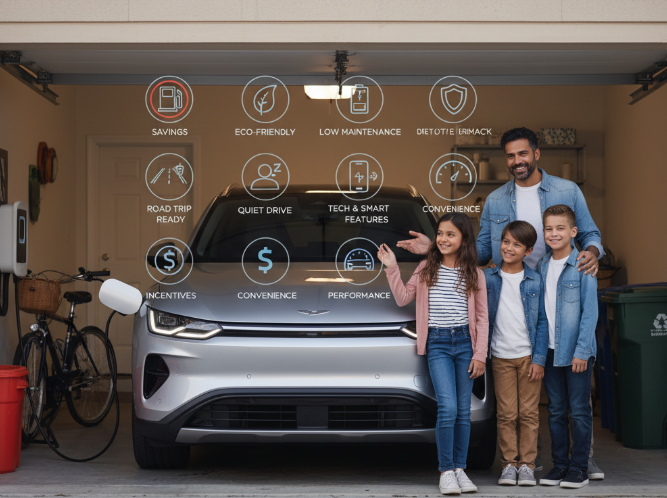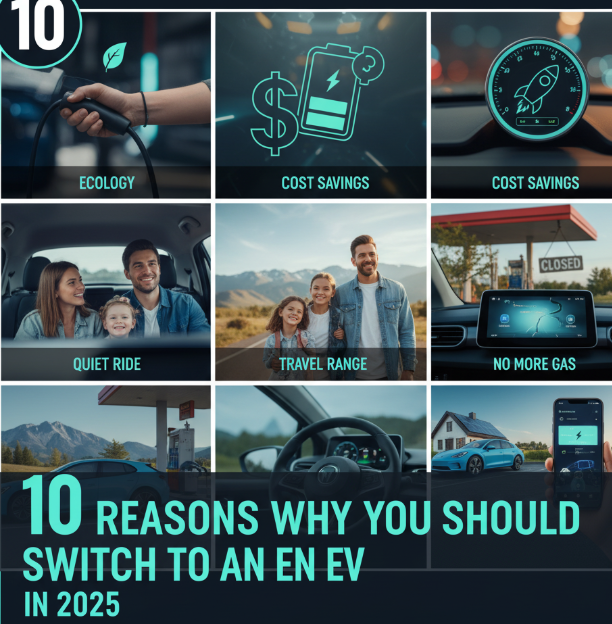Introduction
The year 2025 is shaping up to be a turning point for the auto industry. Electric vehicles (EVs), once seen as futuristic and expensive, are now practical, affordable, and available in nearly every size and style. Governments are pushing for greener transportation, automakers are competing to release new models, and charging infrastructure is growing faster than ever before.
If you’ve been thinking about whether to buy an EV, now is the best time to make the switch. From saving money on fuel to enjoying tax benefits and helping protect the environment, the advantages of driving electric in 2025 are stronger than ever.
Let’s explore the 10 biggest reasons why switching to an EV in 2025 is one of the smartest choices you can make.
1. Lower Cost of Ownership
When most people think of EVs, they still picture a high price tag. But in 2025, things look very different.
Why EVs Are Cheaper Long-Term
- Fuel Savings – Electricity costs significantly less per mile than gasoline. For example, charging at home can cost as little as $0.04 per mile, while gasoline averages $0.12–$0.15 per mile.
- Fewer Repairs – EVs have fewer moving parts compared to internal combustion engine (ICE) cars. No oil changes, no spark plugs, no exhaust systems.
- Battery Warranties – Most EVs in 2025 come with 8–10 year battery warranties, giving you peace of mind.
📊 Quick Cost Comparison Table (Average Over 5 Years)
| Expense Type | EV (2025 Average) | Gas Car (2025 Average) |
|---|---|---|
| Fuel/Electricity | $2,000 | $6,000 |
| Maintenance/Repairs | $1,200 | $3,500 |
| Total Ownership | $3,200 | $9,500 |
👉 Result: You can save thousands of dollars just by switching to electric.
2. Expanding Charging Infrastructure
One of the biggest worries people had in the past was: “Where will I charge my EV?” But in 2025, charging has become more accessible than ever.
Key Improvements:
- Fast Charging Stations: Ultra-fast chargers can give you 200+ miles of range in just 20 minutes.
- Home Charging Options: Affordable Level 2 chargers make overnight charging simple.
- More Locations: Supermarkets, malls, highways, and even workplaces now offer EV charging stations.
🔌 Fun Fact: In the U.S. alone, there are expected to be over 200,000 public charging stations by the end of 2025.
This means range anxiety is quickly becoming a thing of the past.
3. Government Incentives & Rebates
Governments around the world want people to drive cleaner cars. That’s why they’re offering financial rewards for EV buyers.
Incentives in 2025 Include:
- Federal Tax Credits – Up to $7,500 off the purchase price in the U.S.
- State/Local Rebates – Additional $1,000–$5,000 in savings depending on your state.
- Free or Discounted Registration – Many regions reduce or waive vehicle registration fees for EVs.
- Reduced Tolls & Access Perks – In some cities, EVs get free toll passes or access to carpool lanes.
💡 Tip: Check your local government’s website to see what EV perks are available where you live.
4. Cleaner for the Planet
Transportation is one of the largest sources of greenhouse gas emissions. EVs are helping cut down pollution and slow climate change.
Environmental Benefits of EVs:
- Zero Tailpipe Emissions – EVs produce no exhaust, meaning cleaner air in cities.
- Lower Carbon Footprint – Even when charged with electricity from the grid, EVs are cleaner than gas cars.
- Support for Renewable Energy – EVs pair perfectly with solar panels and other renewable energy sources.
🌍 Impact Example: A typical EV reduces about 4.6 metric tons of CO₂ emissions per year compared to a gasoline car.
5. Better Driving Experience
If you’ve never driven an EV, you’re missing out. They’re not just efficient—they’re fun.
What Makes EVs Exciting to Drive?
- Instant Torque – Acceleration is smooth and powerful. Many EVs can go 0–60 mph in under 4 seconds.
- Quieter Ride – No engine noise means a calm, peaceful drive.
- Low Center of Gravity – Batteries are placed at the bottom, giving EVs better handling and stability.
🚗 Driver Review Example: Many EV owners report they’ll “never go back to gas cars” after experiencing the instant acceleration and comfort.
6. Wider Range of Models Available
Gone are the days when EVs were just small hatchbacks. In 2025, you can find electric cars in almost every category.
EV Options in 2025:
- Compact Cars – Affordable, city-friendly EVs.
- SUVs & Crossovers – Family-sized EVs with long range.
- Pickup Trucks – Electric trucks like the Ford F-150 Lightning and Tesla Cybertruck.
- Luxury EVs – High-end models from brands like BMW, Audi, and Mercedes.
📊 Chart: EV Range Improvements Over Time
| Year | Average Range (Miles) |
|---|---|
| 2015 | 90 miles |
| 2020 | 220 miles |
| 2025 | 350+ miles |
The variety of choices means there’s an EV for everyone, no matter your lifestyle.
7. Falling Battery Costs
Batteries are the heart of an EV, and they used to be expensive. But prices have dropped dramatically.
Key Points:
- Cost Drop – Lithium-ion battery costs fell nearly 90% from 2010 to 2025.
- Improved Lifespan – Modern EV batteries can last 300,000–500,000 miles.
- Recycling Programs – Companies are finding ways to reuse old batteries, making EVs even more sustainable.
⚡ Prediction: By 2030, EVs may be cheaper upfront than gas cars due to continued battery cost reductions.
8. Energy Independence
Relying on gasoline ties you to oil prices, which are unpredictable and often politically influenced. EVs give you more control.
Benefits of Energy Independence:
- Stable Costs – Electricity prices are more stable than gasoline.
- Domestic Energy – Many countries generate their own electricity, reducing dependency on foreign oil.
- Renewable Charging – Charging with solar or wind means you’re not dependent on fossil fuels at all.
📉 Example: In 2022, gas prices in the U.S. spiked to record highs, while EV owners avoided the impact by charging at home for pennies.

9. Increased Resale Value & Demand
The demand for EVs is only going up. That means better resale values for EV owners.
Factors Driving Higher Resale Value:
- More Buyers Want EVs – As awareness grows, more used car shoppers are looking for electric options.
- Government Deadlines – Many regions plan to ban new gas car sales by 2035, making EVs more desirable.
- Lower Running Costs – Used EVs are attractive because they’re still cheap to maintain.
📊 Market Trend: The used EV market is projected to grow by over 400% from 2025 to 2030.
10. Future-Proof Technology
Gasoline cars are on the way out. EVs represent the future of transportation.
Why EVs Are Future-Proof:
- Over-the-Air Updates – Many EVs receive software updates that improve performance and add new features.
- Smart Features – Integration with apps, remote monitoring, and advanced driver-assistance systems.
- Charging Network Growth – The future will only make EVs more convenient, not less.
🚀 Long-Term Advantage: By buying an EV in 2025, you’re aligning with where the industry and regulations are headed.
Conclusion: The Time to Switch Is Now
Switching to an EV in 2025 isn’t just about following a trend—it’s about making a smart decision for your wallet, your lifestyle, and the planet.
From lower ownership costs to better driving experiences and government incentives, the benefits are too strong to ignore. As technology improves and infrastructure expands, EVs are no longer the future—they’re the present.
So, whether you’re looking for savings, sustainability, or simply a better ride, 2025 is the year to make the switch to electric.
✅ Key Takeaway: Electric vehicles are now practical, affordable, and widely available. Waiting longer only means missing out on the benefits you could start enjoying today.

Leave a Reply